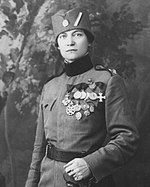User:Sandoria/Sandbox1
| Paretian Union of Reservists União Paretiana de Reservistas | |
|---|---|
 Emblem | |
| Leader | Chief of the Reservistas |
| Foundation | 1919 |
| Dissolved | 1934 |
| Country | |
| Allegiance | Carlos Palmeira Roberta II |
| Political position | Far-right |
| Status | Dissolved |
| Size | 800,000 (1928) |
| Part of | New Nation of Paretia Party |
| Opponents | Paretian Worker Brigades Democrat Freedom Organization |
The Paretian Union of Reservists (Luzelese: União Paretiana de Reservistas), commonly known as the Reservistas, was the paramilitary wing of the New Nation of Paretia Party and eventually the state paramilitary of the regime of Functionalist Paretia.
It was first initially founded in December of 1919 by Carlos Palmeira as the paramilitary wing of the PNNP. It would lead street violence and imtimidation campaigns during the period the PNNP was rising in popularity, eventually when the PNNP came to power after 1925 Paretian coup, they would become the official paramilitary of the government of the PNNP and the 7th of November Movement.
After this it would grow in scale immensely, and would become more of a collection of paramilitaries that would become apart of the 7th of November Movement. It would be used to instill political violence and work with police and military forces in crushing dissent.
It would become more active during the Great War when they would mobilize to aide military forces on the front lines as shock troops. They would be responsible for helping Paretian military forces commit acts such as the Bulaga Massacre against ethnic Etrurians. After the defeat of Paretia in 1934 it was dissolved and banned.
History
Early years
The Reservists were founded as the Army of the New Nation (Exército da Nova Nação), and would become the main paramilitary wing of the National Functionalist New Nation of Paretia Party. It was made in response to left-wing paramilitary groups forming in the months prior.

It's first use was intimidation and scare tactics and street combat. Reservist units were created in numerous cities across Paretia. They would be responsible for numerous battles with left-wing groups such as the Paretian Worker Brigades, the wing of the SPIO.
It's first leader was Diogo Rangel Faria, a former police chief that was able to swing support from police forces in Paretia before Functionalist Rule. This helped them be successful in campaigns against their political opponents.
They played a role in supporting Roberta II and Palmeira's 1925 coup by working with coup members in the police and military in the takeover of the government, notably securing control in smaller towns in the country. The Army would form a loose alliance with the traditionalist Obrigé groups.
Functionalist rule
After the takeover of the PNNP and Carlos Palmeira in November 1925, he formed the 7th of November Movement, the sole governing institution of the new era of Functionalist Paretia. The Army of the New Nation became an official paramilitary wing of the government and was renamed to the Paretian Union of Reservists. It was then expanded in late 1925 to include the Obrigé, Pérolas, and Brigada Naval and major subsects of the paramilitary.
These different groups served different roles, the Obrigé became shock troops and made a large number of the urban combat forces of the Reservistas, female and youth sections of this group also existed and had more pacifistic roles. The all-female Pérolas were a enforcement group that were used to crush dissent and police the Reservistas itself. The Brigada Naval was the naval wing of the Reservistas that became essential in deportations of those the government did not want in Paretia, including ethnic Rahelians and Bahians who were sent to Tsabara.
Great War
Organization and sections
The Reservist unification in 1925 lead to new groups joining including the Obrigé, the traditionalist monarchist paramilitary movement in Paretia. The government added to new sections to the Reservists as well, including the Pérolas, an all-female section of the Reservists inspired by the Veuves de Sainte Chloé in Functionalist Gaullica.
Obrigé
The Obrigé were supporters of the Monarquistas Absolutistas, a traditionalist monarchist group that advocated that more power be given to Roberta II. They had existed since the rule of Roberta I and saw the rise of the PNNP and Roberta II's membership and leadership within as a change to bring more royal power to Paretia.
They joined the Reservistas in 1925 after the November 7th Coup, in what was called the Coalition Decree that brought in many military and traditionalist elements under the umbrella of the PNNP's new government. The Obrigé were lead by Xuaco Parrondo, nicknamed El Director (The Director) in Esmeiran, he was the lead negotiator on political between the traditionalists and functionalists.
They were made up of both youth and female groups that were given different roles than the adult men, women would become flag bearers and children music players for members of the Obrigé.
They would become active members of the Reservists and the made up much of the shock troop groups used during the Great War against Etruria. Palmeira called them "furious fighters that can change the prospects of a battle ground". Many members of the Obrigé were not functionalists and somewhat against the ideology, and when the Paretian regime fell many would leave the force.
Pérolas
After Roberta II visited Gaullica in 1925, she advocated to Palmeira and Rangel for the creation of a all-female paramilitary unit based upon the Veuves de Sainte Chloé lead by Gwenaëlle Cazal. The PNNP would create a unit soon after.

This unit became known as the the Pérolas (Pearls), this group would be used differently than the female members of the Obrigé and was mainly used for violence and policing. This unit was lead by Izabel Grilo, nicknamed A Pérola Sangrenta (The Bloody Pearl).
During the Functionalist government they used intimidation tactics and threats against dissenters. Tactics used include kidnapping, physical violence, and blackmail.
Palmeira stated about the Pérolas that "They are a showcase of the power of the functionalist state, it can be projected by both men and women. They bring fear into the diseases that infect the nation of Paretia". Minister of the Interior Rafael Azevedo praised the group for their dedication to the government.
During wartime they were used in espionage and in warfare as well as medical support and in rare cases combat. When the war ended in Paretia in 1934 the Pérolas were disbanded and banned.
In 1925 the government also created a naval section of the Reservists. The Brigada Naval of the Reservistas was made to promote Paretian maritime control and were heavily affilated with the Paretian Naval Armada. It was lead by Emilio Vargas
The Brigada Naval was given the role of aiding in the deportations of groups such as Etrurians, Bahians, and Rahelians. These deportations conducted by the Paretian government using numerous agencies and units are responsible for displacing over 11,100 people to Tsabara.
During the Great War the Brigada Naval would be apart of aiding the Naval Armada, such as helping send supplied and troop movements around the coastline, Aurean Straits, Solarian Sea, and Gulf of Assonaire. It was disbanded in 1934.
Oath and War Chant
Oath
The oath of the Reservists was: "I give my blood to keep my nation alive and healthy, I devote my blood to the Reservists, the 7th of November, Carlos Palmeira, and her Majesty. Acima Paretia."
War Chant
The chant of the Reservists was:
|
Reservistas, quem vive? |
Reservists, who lives? |

